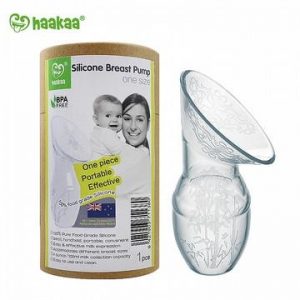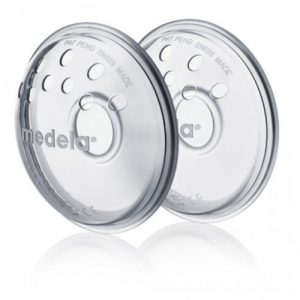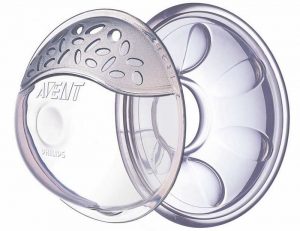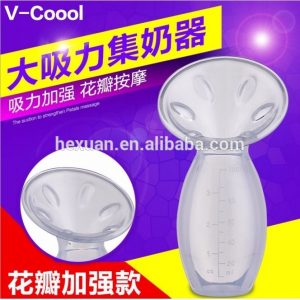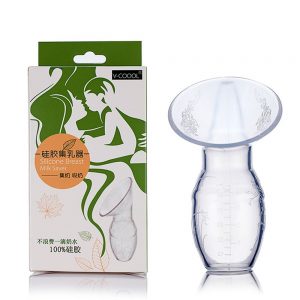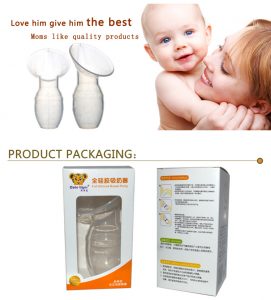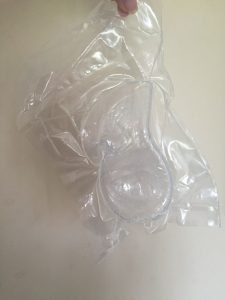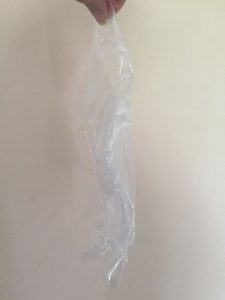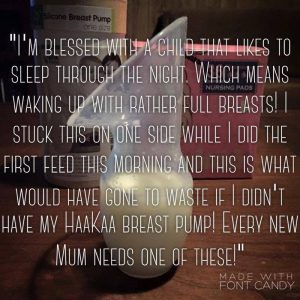By Shel Banks, Chair of LIFIB, Infant Feeding Information Specialist and IBCLC
An earlier version of this piece was first published on the blog for Growing Families ahead of their conference in Manchester in October 2016. This current piece has been amended and updated as new information has been made available, and to the best of our abilities we will continue to amend and update where new evidence is produced which materially changes the content.
This year’s big thing in the infant feeding related products world seems to be the Haakaa silicone breast pump. Coming from New Zealand, the company information on Facebook says they are a “baby brand that provides parents with Safe, Natural, Non-toxic, Eco-friendly baby products” http://www.haakaa.co.nz/ The ‘buzz’ around this product is so strong that people all over the UK have been importing from the other side of the world so they can get their hands on this item, and leaving rave reviews! I have been hearing a lot about them and wanted to provide a good discussion of what the fuss is all about.
This new-ish product is essentially a clever combination of two items which have been around for a long long time – breast shells and breast relievers.
Breast shells are designed to be tucked into the bra of a lactating woman, and the hole goes around the nipple so that any leaked milk is caught in the ‘shell’. The shape of the part which touches the breast, and the size and placing of the hole, creates gentle pressure on the lactiferous ducts behind the areola and actually encourages milk flow and so stimulates leakage.
Breast relievers are designed to pump milk from the engorged breasts of lactating women when the baby they have been feeding baby cannot or does not wish to be fed. They rely upon a combination of suction (creating a vacuum which draws the milk out), rhythm (which might stimulate the ‘let-down’ reflex) and pressure on the lactiferous ducts, which stimulates milk flow. These devices have been around for well over 100 years and are still used today. See this one  in the British Science Museum which was apparently in production between 1870 and 1901, although many like this were used much more recently – but also this one which is one of many similar ones available online now.
in the British Science Museum which was apparently in production between 1870 and 1901, although many like this were used much more recently – but also this one which is one of many similar ones available online now. 
Where these have been promoted as breast ‘pumps’ in the past I have been a little concerned as this suggests the milk is being saved for use in feeding baby, and I’m never sure how one would effectively clean the ‘bulb’ – which both gets squeezed to create the vacuum / pumping, and also serves to store the collected milk. Nor whether the plastics or rubberised materials used, might leech substances into the milk – which is a worry if this is to be used for feeding baby, but of less concern of course if it is purely used to relieve engorgement and the resulting milk is discarded. However I don’t know many lactating women who are happy about the idea of discarding breastmilk!!
So when I first saw the Haakaa in a breastfeeding group online I was impressed by the simplicity of the design and the ethos behind it – namely that it’s simple to care for, and non-toxic!
How does it work?
For this we can turn to the company’s own website: “Simply suction to your breast and let the pump do the work for you as it draws your milk using suction”. It’s true – the reports I have had tell me that the flange is placed on the breast, nipple lined up with the ‘neck’ of the device, and then the bulb is squeezed to compress which expels air from the bulb and creates a vacuum around the flange on the breast, securing it to the breast. Mums tell me that they then feed their baby on the other breast and while they are feeding the device fills up with their milk! The device has a scale on the side up to 90ml but I suspect it would accommodate 100ml – whether it could do this without falling off the breast as the vacuum reduces and the device itself becomes heavier with milk, is another matter – but you could hold it on.
How is it different from other pumps?
Most breast pumps work in a similar way – there’s a flange or funnel which sits on the breast, a hole and tube which accommodates the nipple, and then something on the other side to provide the vacuum in a rhythm so that it does actually pump the breast. Usually there’s some sort of valve so that the milk once removed from the breast is released into a bottle via some sort of ‘one way’ affair and cannot come back out again into the body of the pump. Whether hand pump or electric, whether double or single, costing £10 or £200 – all the same basic design. So there are at least 4 parts, of which at least 2 are moving. Usually many more than 4, and first time assembly for the exhausted new parent is akin to completing a passport application using only your mouth to hold the pen! But the Haakaa is just one piece of silicone and not really a ‘pump’ at all – no valve, no pumping required – though the manufacturers do say that you COULD squeeze and release the ‘bulb’ at the bottom, which contains any milk, if you choose to – it isn’t necessary. Because it involves no ‘pumping’, in spite of the dictionary definition of pump only meaning to move liquid through suction or pressure, for some reason I’m a little uncomfortable calling it a ‘pump’ and am finding myself using the word ‘device’ to describe it!
How can it be cleaned?
Unlike any of the more complicated ‘moving part’ pumps there’s only one piece to this device which makes it far simpler to wash inside and out (in hot soapy water) and of course no assembly required. Unlike its predecessors the breast reliever, Haakaa’s device is also dishwasher safe (not sure how to position it so that it would definitely get washed and rinsed thoroughly, however – dishwashers tend to send small light things like this spinning around inside the machine during the cycle, in my experience), and because we don’t want any nasty things leeching into baby’s milk they are made from 100% food grade silicone and certified BPA, PVC and Phthalate free. So it’s as simple as it looks.
Which brings us to a troubling issue with these devices:
Copycat pumps.
Since these devices have become popular, almost inevitably some copycat devices have spring up on the internet – some in China, some in Malaysia. Examples here
Some look identical to the Haakaa, some do not, and are not. The authentic Haakaa pumps were originally available only from New Zealand, costing $27NZ (about £15) and it was not possible to buy them from the UK without relatively high transport costs. The main (New Zealand-based) websites selling them would charge around £27 to sell and deliver one to an address in the UK, within about 2 weeks. UPDATE: at the bottom of this piece we have included a link for purchasing in the UK, updated 28th August.
However, the copycat pumps are available through amazon and other mainstream retailers, claiming prices from as little as £3 delivered! From the families I have spoken with who have ordered these copycat pumps, I know that the very cheap ones often do not turn up at all, and sometimes the refunds have been impossible to secure, also that even the £12-20 ones have been arriving without proper packaging – this is one example given to me by a local mum
As you can see – the packaging isn’t quite as sophisticated!
These copycat pumps are often more ‘solid’ than the authentic Haakaa, made from a material that feels more rigid to the touch, and weighs more – 100g compared to 74g. This suggests they are not made to the same standards as the authentic Haakaa. Reviews on some of the copycat pumps on eg Amazon.com suggest that this thicker silicone actually causes pain when it is suctioned onto the breast, and there have been reports of burns to the skin, like chemical burns, from users – the reviews on some of the third party selling sites containing these damning claims have now been removed as far as I can see.
Interestingly the copycat pump shown above donated by a local mum has a different pattern on the silicone to the Haakaa, but the design is identical and it’s just as squishy – even came shrink- wrapped squished in the post as you can see above! BUT it weighs LESS than the authentic Haakaa – so the copies are getting more sophisticated but still are not the real thing. The copycat pumps sometimes have Chinese lettering on them, whereas the authentic Haakaa one, a representative from the company tells me, have the word HAAKAA written down the side.
The authentic Haakaa pumps are certified BPA free. BPA is Bisphenol A – an industrial chemical used in the production of polycarbonate which is a hard, clear plastic, used in many consumer products. BPA is also found in epoxy resins, used as a protective lining on the inside of some metal-based food and beverage cans. It also leeches into liquids and is now thought to be carcinogenic, to which end it has been banned from the production of baby bottles since 2011 in the EU.
Buyer Beware!
Copycat pumps make some claims on the advertising and packaging but we cannot of course be sure if these are true. One mother I spoke to was concerned about these copycat pumps and, fearful she had bought one, she emailed the seller to ask if they were safe and what testing they had had. The response she received was that they had no idea, they were just selling and sending them out. In the UK/EU the importer actually has the responsibility for the safety and conformity of imported products, the ‘CE markings’, so if a UK resident is importing things from abroad then as the importer, THEY are responsible for checking that the products are appropriately CE marked for conformity to required standards.
Are they any good?
Assuming we’re now talking only about the authentic Haakaa silicone pump, what most families will want to know, I imagine, is are they any good?
If you go online and search for Haakaa reviews, a few clicks will bring you many many positive stories, lots of five star feedback, youtube videos and so on. The point is it’s a simple idea, and it works. Gentle pressure on the lactiferous ducts, plus gentle vacuum as the bottle expands, plus feeding baby or active pump on the other breast to create a ‘let-down’, will elicit a flow of milk into the device. Some women find they could completely fill it, others just an ounce – but as many mothers have told me – they have always failed at expressing, they are no good at it, and this device gives them an ounce they would never otherwise have had! Mothers who have trouble with leakage while feeding on the other breast and so use lots of breast pads, are finding this saves them lots of breast pads and leakage AND gets them some milk to store.
A word of caution though – a quick search of reviews online shows that some babies think it’s a great game to knock them off the other breast as they are feeding, and because of the design, a knocked Haakaa pump can spill ALL the milk collected – up to 4 ounces – all over the place. So now you have been warned about that, there’s no use crying…!
Lots of rave reviews however, and little images sent in of milk collected in them!
Are there any drawbacks?
However because they apply the gentle pressure on the lactiferous ducts AND a gentle suction too, they will encourage continued leaking and can exacerbate the issue for anyone for whom leaking is already an issue; so as breasts are really supposed to work individually – assuming you are feeding only one baby! – if you have a problem with leaking from one side when the other is ‘working’, or perhaps a slightly different but related issue such as an over-supply, perhaps it’s better to manage that rather than encourage more of the same by collecting the milk in a device like this. See someone qualified and experienced in supporting mothers with breastfeeding issues – perhaps from the voluntary sector (ABM, BfN, LLL or NCT) or an IBCLC www.LCGB.org/Find-An-IBCLC has a list of local practitioners.
Nutritional content of milk collected
One final potential drawback of these devices which should be noted before going ahead and using or encouraging their use, is that used as described above, ie simply attached to the breast and left to gather milk which is spontaneously ejected from the ‘other’ breast while feeding or expressing on the first breast, they may basically collect ‘drip milk’ which is not suitable for use exclusively as a full feed for baby, as it’s the watery carbohydrate-rich milk, not the fattier richer milk. Fat soluble nutrients will be contained in the fattier richer milk in greater quantities. Babies feeding directly at the breast of course access the full spectrum of milk which the breast is capable of making, via a combination of variations in pressure, suction and mum’s letdown.
If milk collected by the Haakaa or any other collection device is used as an occasional drink to be left when mum isn’t able to feed, then probably the only negative issue would be baby being slightly less satisfied or needing slightly more volume to become satisfied – not a big deal. However if you fed nothing but ‘drip milk’ to a baby it would not do so well. In milk banking ‘drip milk’ is not suitable for donation because it is not whole milk, essentially it’s skimmed milk.
A very quick search for evidence to corroborate my assertion about ‘drip milk’ when chatting online about the potential drawbacks of this device, brought me this from 1978 http://www.ncbi.nlm.nih.gov/pubmed/571325 – the author of that piece Alan Lucas does take money from the infant formula industry (though this was long ago so not sure whether this pre-dates the industry money) and so some may pooh-pooh the impartiality of his work, but we cannot dismiss everything he does on that basis alone – he has come up with some interesting stuff! And industry-funded work is often extremely informative too – no sense throwing the baby out with the bath water so to speak!
I know too from my experience working withthe UK Association for Milk Banking UKAMB for these past many years, and as a member of the 2009/2010 Development Group for NICE Guidance on Milk Banking, that the donation or collection of ‘drip milk’ is not recommended within milk banking as it is not suitable for fully-feeding growing vulnerable babies in the NNU, because of the nutritional shortfalls it may have. However, as an antidote, of course one could hand express a little of the much fattier richer milk from the breast after a feed, to even up the nutritional composition, and make it more suitable for using as a full milk feed. The best ‘how to’ guide I have seen online for massage before pumping and for expressing by hand is to be found here.
Because of the vacuum, it’s likely to be slightly less ‘drip milk’ than milk which is REALLY dripping out, but not much more than the milk elicited by the breast shells which apply pressure to the areola. In some of the photos posted online, the colour of the milk is suggestive of higher water / carbohydrate content and lower fat content – but of course composition of breast milk will be slightly different from mum to mum and from one session to another, and it’s impossible to judge nutritional content from a photo posted online! Haakaa confirm that there are no studies to determine the nutritional quality of the milk elicited as yet, and as a non-clinical researcher I’m certainly not in a position to provide this evidence myself.
It’s worth pointing out too, that though Haakaa’s website says “simply suction to your breast and let the pump do the work for you as it draws your milk using suction”, apparently the instructions inside the box that comes with the genuine Haakaa also state that milk can be elicited by ‘pumping’ the bulb of the device.
Other online blogs about this product
Most of the blogs I found – a quick google search brings up loads! – seem to be rave reviews about the product, or akin to an instruction manuals, rather than a look at how they work and why it’s so important to get an authentic one and not a copycat: however in this FB post from May, Ellen from New Zealand, who is a midwife, compares the ‘China Cheapie’ to the authentic Haakaa pump, and shows that they cheaper one is less flexible and much heavier.
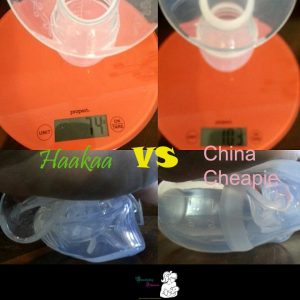
Taken from Breastfeeding Illawarra’s post about the Haakaa and the ‘China Cheapie’!
As reported above however, newer copycat pumps are now on the market which look much more like the authentic pump, and behave in a similar manner – the pattern on the pump is different on the one I have (authentic Haakaas have a bamboo pattern – this one is flowers!), but the shape, feel and function are almost identical. The main factors pointing to a copycat pump rather than an authentic Haakaa device are the packaging – this one arrived in the shrink-wrap shown earlier, and stuffed into a plastic mailing envelope, not the cardboard tube of the Haakaa pump – and the weight is just 5g less. So we have no idea what it is made from or where it was made.
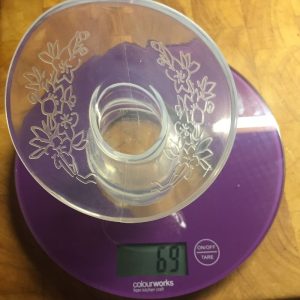
As with everything, Buyer Beware – and in this case, you definitely get what you pay for – so if the Haakaa is the pump for you then be sure you order a genuine Haakaa!
One final note – I have, at time of writing, not seen a genuine Haakaa pump – and I have not trialed it as I am an IBCLC and researcher, not a lactating mother anymore, so this is all theoretical and historically based and gathered from currently available evidence. I would welcome new evidence or experience on anything related with which to update this piece.
Haakaa have updated me that the pump is now available direct in the UK, via Amazon at £16.10 including delivery via Amazon Prime – and since I have heard that people importing from overseas have been billed for import duty in some cases, this seems like the best way to buy now!
AUGUST 2016
.

